2006 NYC Voting Machine Demo
As required by the Help America Vote Act (HAVA) (or the Help Republicans Get Elected Act), New York City was forced to get electronic replacements for the venerable old lever machines that have nobly served the city for over half a century. The NYC Board of Elections provided two public demonstrations of the proposed new equipment in advance of a public hearing on November 21, 2006 (strategically timed two days before Thanksgiving) and a series of public vendor interviews that were scheduled to precede a final order in March that was ultimately delayed.
I attended the session on November 15, 2006 in Queens with a group from Democracy for NYC and, far from alleviating my concerns about the new machines, it raised even more issues that aren't always fully discussed when the contentious topic of voting machines arises.
There were four vendors bidding with five different systems:
Diebold offered a paper ballot / optical scan (PBOS) system to New York that featured a user-marked paper ballot fed into an AccuVote optical scanner at each precinct. Ballots are marked in simple, cheap plastic privacy booths then physically carried over to the scanner, which alerts the voter of any overvotes (multiple candidates marked for a single office) or undervotes (no votes for an office or proposition). An AutoMark touch-screen terminal is provided for the handicapped to enable independent marking of paper ballots that are then fed into the same scanner used by non-handicapped voters. At the end of the day, a paper printout of the totals and the scanner memory card are carried by the police to the local police precinct for communication to the Board of Elections main office. The final tabulation is handled by the notorious Global Election Management System (GEMS)(R) software.

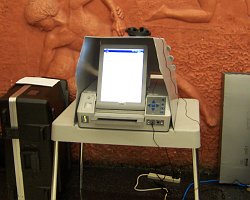
Since getting into the elections business in 2001, the name Diebold has become synonymous with election systems problems and questionable polling results. The atmosphere surrounding technical problems have complicated by utterances from former Diebold CEO and Bush "Pioneer" Wally O'Dell, who resigned from Diebold in December 2005 in the face of fraud allegations. Given the controversy, Diebold is considering leaving the elections systems business in order to protect a brand name which is associated with a much larger and more lucrative ATM, software and security business. This does not bode well for a city seeking a long-term election solution.
ES&S offered a system that is almost identical to the Diebold system. In fact, the AutoMark ballot marking terminal is the exact same AutoMark machine and, although the ballot scanner is different hardware, from the voter and poll worker perspective, the experience is basically identical. The distinction between Diebold and ES&S seems to lie in the software. ES&S machines use a Linux-based operating system (the only non-Windoze machine in the bunch) and, supposedly, the code has been examined and favorably reported on by NIST, the Election Science Institute, and Compuware. I can't vouch for the validity or integrity of these reports.
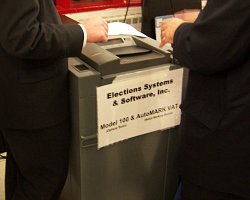
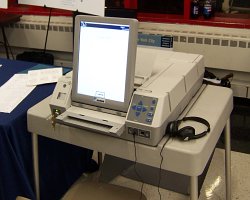
The similarity with Diebold was understandable since both Diebold Election Systems and ES&S have their roots in American Information Systems, a company founded in 1976 by Bob Urosevich. In 1995, Bob Urosevich, started I-Mark systems to market touch-screen voting systems. I-Mark was bought by Global Election Systems in 1997 and GES was purchased by Columbus-based Diebold in 2000. Meanwhile, Bob's brother Todd, remained at Omaha-based ES&S, which at one point (still?) was partially owned (35%) by Nebraska Senator Chuck Hagel.
Avante International Technology is a Princeton-NJ-based company (with their factory in California) offering the Vote-Trakker EVC 308-FF, a large and impressive looking Direct Recording Electronic (DRE) system with a 42-inch LCD touch-screen and a voter-verifiable paper trail. The voter experience with the machine is extremely interactive and complex, with color-coded alerts to indicate under/over-voting. The paper "ballot" is a narrow strip of paper that appears behind a window to the right of the touch-screen and can be validated by the voter prior to casting the vote.
An obvious concern with the Avante machine was the complexity of the user interface and its potential to confuse and disorient voters who are not savvy computer users accustomed to complex computer interactions. In response to my query about this issue, a salesman stated that they had successfully used the exact same software in Warren County, NY with no complaints. However, the absence of complaints does not indicate the absence of problems, especially by non-technical users who may be loathe to cause a fuss or elections with smaller and less-complicated ballots. The folks at Avante should also probably should learn to spell "tracker" before marketing their product.
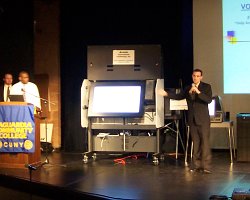
Sequoia is offering both a touch-screen (DRE) and paper-ballot / optical-scan (PBOS) system. Sequoia is a New York-based company that started in 1905 and is the provider for the current absentee voting tabulating equipment. They provided the original lever machines and are deeply embedded in the New York election process. In fact, the DRE is designed to be operated by poll-workers and voters with almost the same controls and procedures as the current lever machines. The DRE paper trail is a strip of paper along the right side of the touch-screen, so similar to the Avante machine that Avante is suing Sequoia. The alternative ballot scanner is operated in a manner almost identical to the Diebold and ES&S machines - in the words of the sales rep, "Optical scan is optical scan."
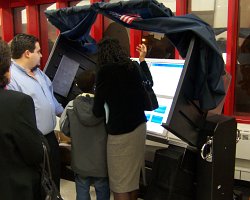
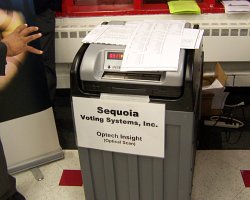
Issues With Touch Screen Machines
The general consensus on the Left (with the notable exception of the handicapped community) seems to be favoring paper ballots over touch-screen (DRE) machines, regardless of whether the touch-screen machines offer a paper trail. The issues surrounding universal use of touch-screen seem almost insurmountable:
Equipment or Power Failure: DREs are complex machines that present multiple failure modes and require specialize training (and/or expensive service contracts) for maintenance. If a machine goes down due to a hardware problem or if multiple machines go down due to a design flaw, voter disenfranchisement will occur. Even if "floating" machines are allocated for replacing failed machines or if paper ballots are available, delays associated with diagnosing problems and making the decision to go to the backup plan will result in voters walking away from the polls without voting. And while paper ballots can still be marked and collected in the event of a long- or short-term power failure, DREs are useless without juice.
Software Bugs: Software testing is a very inexact science. Because of the scale of system deployment, an election system can only be fully tested at its most critical life cycle moment - on election day. There is no second chance if something goes wrong and, as with hacking, election officials are almost totally dependent on vendors with a vested interest in concealing problems. Although the software and hardware have matured significantly over the past few years, complex systems will always have bugs. The question is whether the benefit is worth the risk.
Deliberate Programming Flaws: Since election system software is complex and proprietary, one cannot say with complete certainty that the software is accurately counting the data that has been input or that a corrupt developer or development team has not hidden code or backdoors that permit validation prior to election day while manipulating the final results on election day. While this may be more suspicion than documented history, with a complex system that is opaque to voters and election officials, the potential is significant and probably the single most disconcerting issue to voting machine activists.
Hacking: While all of the proposed machines were proudly touted as having no ability to communicate with the outside world through wired or wireless paths (as mandated by state law), the central tabulating software almost certainly runs on Windoze computers that can be penetrated by determined individuals or organizations for the purpose of manipulating final vote totals. Although all vendors tout their use of state-of-the-art security techniques and encryption algorithms, no computer system can ever be made 100% secure, either from external threats or corrupted election workers. While the technical barriers can be rightfully touted as an impediment to fraud, the complexity of the software, combined with an almost complete dependence on contracted support personnel with a vested interest in concealing problems, has the potential to permit serious attacks to go undetected. In fairness, the potential for central tabulator hacking is an equal problem regardless of whether votes are collected via touch-screen or optical scanner.
Machine Printed Paper Ballots are Problematic: The Avante and Sequoia machines print results on paper that, theoretically, can be verified by the voter and used by election officials in the event of a recount. However, the paper display is small and, in the context of a huge, bright touchscreen display, fairly inconspicuous. Since the paper display is not the actual voting artifact, it will doubtless be overlooked by many voters, especially if the ballot is long or if there a large number of surly voters waiting in line for the machine. Issues that arise during the voting day cannot be addressed by poll workers and voters who raise the issue after election day will be dismissed as "conspiracy theorists". While the vendors all proclaimed the reliability of their printers, given the vagaries of climate and paper conditions and the technical knowledge and authorization required to clear jams or change paper, even limited failures on a large number of machines could call into question the validity of a recount in a very close election. And since manual counts are usually only initiated in the event of a very close race, the paper trail is useless if it is never used.
Complexity of Use: Even I as a relatively knowledgeable computer user was somewhat overwhelmed by the complexity of the DRE user interface. The strong sensory stimulation of a large, bright screen in an unfamiliar environment is a complicating factor. Despite protestations by vendors to the contrary, I feel certain that some voters will be intimidated by these machines and either require extraordinary amounts of time to complete ballots or, worse, walk away from the process entirely out of fear or disgust. The affected number of people may be small, but this could be a factor in a close election.
Poll Worker Burden: While poll workers deserve our respect and thanks, poll staffing is thankless, low-paying transient work that, because elections occur on Tuesday, is usually not sought after by folks with regular jobs or familial commitments. Training for poll workers is limited by logistic and budgetary constraints and retraining for completely new processes associated with new machines will be problematic. Given the current shortage of poll workers, introduction of extremely complex machines threatens chaos if there are even mild technical problems.
Cost: Touch-screen machines are, obviously, very expensive capital items, although none of the vendors would give sample or comparative prices and the actual cost will certainly be subject to a bidding process and backroom dealing. There is a legitimate question about whether the total cost of operation is comparable or even lower than paper ballots when the costs of printing, training and transportation are considered. But given the ever-increasing rate of technological change, new machines will certainly have a lifetime exponentially shorter than that of the old lever machines and may become obsolete before they pay back the differential in costs relative to cheaper (but not cheap) scanners.
Paper Is Not A Perfect Solution
The general response to the issues with touch-screen machines has been a cry for return to the use of paper ballots. However, in the strong reaction to hastily implemented voting machine laws, problems with paper ballots can easily be overlooked:
Machine Counting is Inevitable: In a city that cast 2.3 million ballots cast in 1,369 precincts during the 2004 election, voting in NYC represents a significant information technology challenge. Hand counting of 2.3 million ballots would be hugely expensive, extremely time-consuming and fraught with human error. Machine counting and tabulation of votes is inevitable, bringing with it many of the same software issues as DREs. For those of us who routinely vote absentee and take comfort in our tangible paper ballot, those ballots are currently counted by Sequoia scanners. In addition, the new State and Federal rules mandate replacement of the old machines (the stick) and the State will get $50 million towards the effort (the carrot).
Paper ballots are Also Subject to Undetectable Tampering: The only way to protect the vote count with paper ballots is to protect the physical security of the ballot boxes. Since the physical security of the ballot boxes is entrusted to civil servants who are largely invisible to the larger electorate, there is little to assure voters that their paper ballots ever made it to the counting process or were not tampered with prior to a recount. Ballot stuffing, destruction and replacement are classical election manipulation techniques that go back centuries and are totally reliant on the complete integrity of hundreds of election workers. The return to paper ballots will certainly provide fodder for right-wing activists to continue to erroneously spread claims of vote fraud. In speaking with the Sequoia sales rep, I discovered that, to preserve confidentiality, NY State law does not permit the use of any sequence or identification numbering on the ballot forms. Ballots are identical and only distinguishable by the voter markings. There is no way to determine whether a ballot is legitimate.
Paper Ballots are Useless Unless They are Recounted: Most jurisdictions only permit an expensive and time-consuming hand recounts if the election falls within a very small margin of difference. Given the avenues for physically or electronically manipulating the vote counts prior to release of the initial results, it would be relatively easy for a small number of people to keep a close election from ever reaching the point of needing a recount.
User-Marked Paper Ballots are Prone to User Error: Paper ballots involve making some kind of mark with a pen to fill in a space that is then read by the scanner. The new generation of scanners currently being offered by vendors are designed to alert voters if they have overvoted (selected more than one candidate for an office) or undervoted (failed to select a candidate for an office). However, in the event of a manual recount, the markings of the voter are subject to the opinion of the auditors and can present ambiguity if the markings are not clear or if stray markings appear on the ballot. As with Florida 2000, in a close election, ambiguity on even a small fraction of 2.8 million would offer fodder for questionable legal action and unending controversy.
Conclusions
While I personally still favor paper ballots over touch-screen machines and Oregon-style mail-in balloting over in-person poll voting, the opportunity to directly see the different options has led me to some tempering of my strong opposition to DREs. There is no hardware solution to the problem, only a weighing of whether the solution only makes the problem worse.
Ultimately it's not who votes that counts, it's who counts the votes.